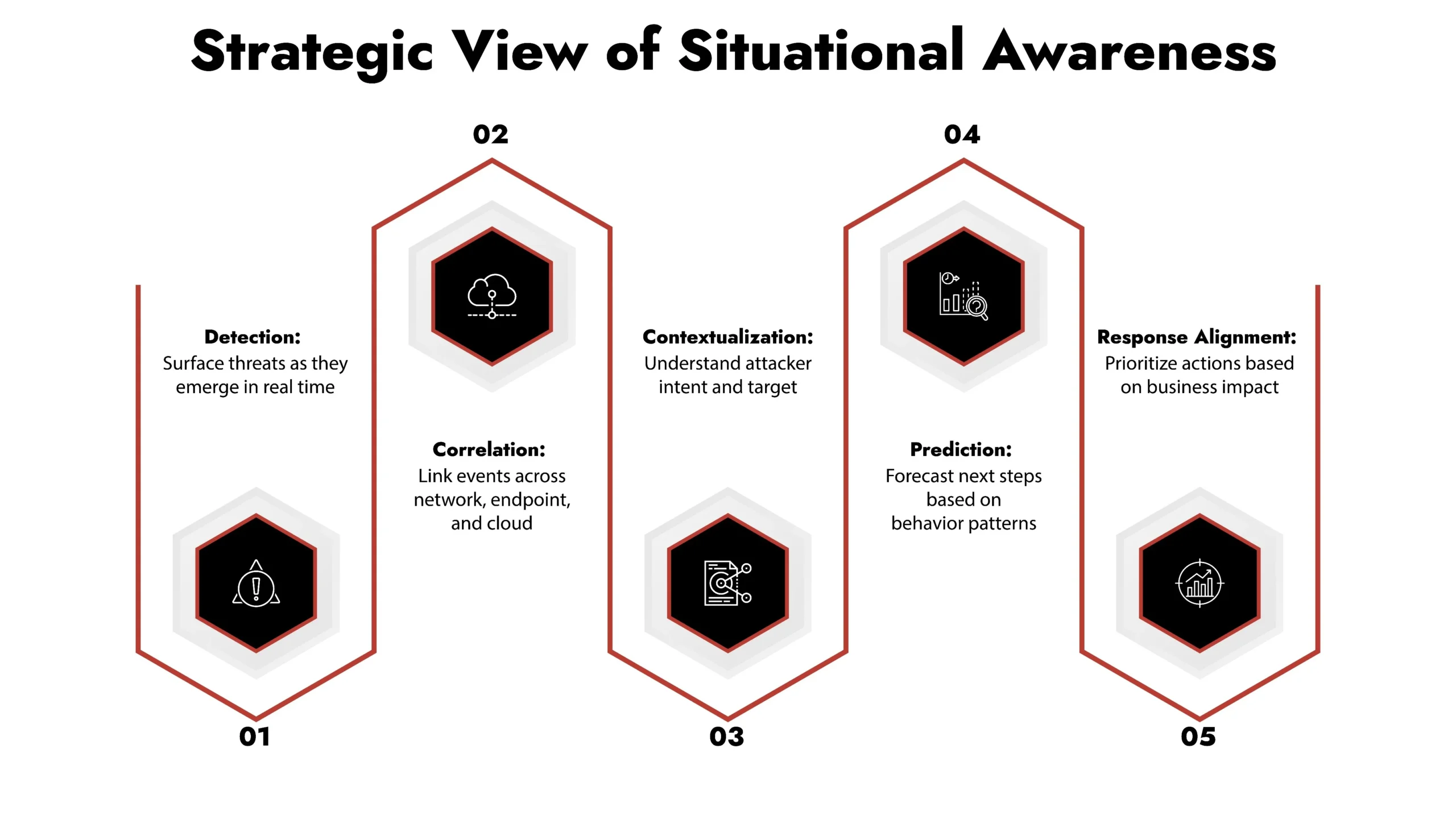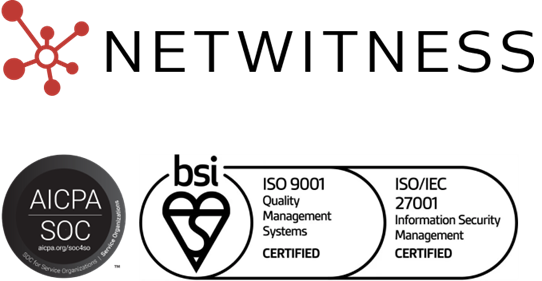Cybersecurity threats rarely show up out of nowhere. In most enterprise breaches, signs were present long before the damage was done. But without situational awareness, those early indicators go unnoticed, buried in noise or lost in silos. That’s what turns a minor anomaly into a full-scale incident.
Situational awareness isn’t just a military or physical security term anymore. In cybersecurity, it’s the foundation of incident containment and remediation. Without a clear, real-time picture of what’s happening across your network, endpoints, and cloud assets, you’re reacting in the dark.
Let’s break it down.
What Is Situational Awareness in Cybersecurity?
Situational awareness in cybersecurity is an organization’s ability to perceive threats in real time, understand their context, and anticipate their next move. It’s not just about spotting alerts, it’s about seeing the bigger picture: the who, what, where, and why behind an attack.
Think of it like a military radar system. It doesn’t just light up when something enters the airspace. It shows direction, velocity, altitude, and potential intent, helping commanders make split-second decisions. In the same way, cybersecurity situational awareness brings together visibility, context, and intelligence so defenders can act before threats escalate.
At its core, situational awareness means:
- Understanding what normal behavior looks like across users, devices, and networks.
- Mapping critical assets and how they’re interconnected.
- Monitoring who is accessing what and whether they should be.
- Recognizing attacker TTPs (tactics, techniques, and procedures) in the moment.
- Predicting likely outcomes if a threat isn’t addressed immediately.
- With this level of awareness, security teams move from reacting after the fact to containing threats before they cause harm.

Why Situational Awareness Comes Before Containment
Containment isn’t just about stopping an attacker mid-action; it’s about gaining control of the situation and limiting potential damage! When you have control, you can better understand the motives and capabilities of the attack. You’re playing chess, not checkers!
Without situational awareness, most teams default to containment measures that are either too slow or too blunt. That might mean quarantining the wrong systems, missing lateral movement, or failing to recognize that a ransomware detonation was just a decoy for data exfiltration elsewhere.
The point? Containment without awareness is reactionary and leaves the attacker in control.
With proper situational awareness in place, you can:
- Isolate affected systems without disrupting critical services.
- Detect lateral movement across hybrid infrastructure.
- Confirm which identities and credentials were compromised.
- Identify patient-zero and track the full kill chain.
- Guide forensic investigation and IR strategy.
This shifts the incident response from reactive panic to controlled execution.
Core Components of Cyber Situational Awareness
1. Full Visibility Across All Domains
You can’t defend what you cannot see. True situational awareness requires telemetry from:
- Network traffic (north-south and east-west).
- Endpoints (EDR or native OS logs).
- Cloud workloads and containers.
- Authentication and identity data.
- Threat intelligence feeds.
The goal is to eliminate blind spots, whether from encrypted traffic, unmanaged devices, or siloed SaaS tools.
2. Behavioral Analytics and Anomaly Detection
Indicators of compromise (IOCs) are useful, but they’re lagging indicators. By the time a signature is matched, the breach has likely begun. Behavioral analytics offer earlier signals by spotting deviations from normal patterns.
Look for:
- Unusual login times or geographic access.
- Sudden privilege escalations.
- Large-scale file movements.
- Abnormal protocol usage.
These behavioral signals, correlated in real time, give responders early warning and precision.
3. Threat Intelligence Integration
Situational awareness needs an external context. Who’s targeting your sector? What TTPs are trending in the threat landscape? Mapping internal telemetry to known campaigns helps prioritize what matters.
This lets IR teams triage alerts with surgical accuracy rather than drowning in noise.
4. Asset and Identity Context
A threat against a low-priority test server isn’t the same as one targeting your Active Directory controller. Contextualizing threats against asset criticality and user privileges makes incident containment smarter.
You need to know:
- Where the crown jewels are.
- Who has access to them.
- How attackers might pivot to them.
Situational Awareness in Action
Imagine your SOC detects a spike in DNS traffic from an internal host to an unfamiliar domain. Without situational awareness, this could be dismissed as noise or flagged too late.
With it:
- Network telemetry confirms the destination is linked to a known C2 infrastructure.
- Endpoint logs reveal PowerShell usage and credential dumping tools on the host.
- Identity data shows the compromised user had lateral movement rights.
- Asset context flags the host as adjacent to a production finance server.
- The IR team immediately isolates the endpoint, resets credentials, and begins forensic capture, containing the threat in minutes, not hours.
That’s the difference situational awareness makes.

Where Containment Ends, Expulsion and Remediation Begins
Containment is the most strategic and delicate phase of incident response. It’s not just about stopping the bleeding; it’s about making high-impact decisions under pressure, with incomplete information, and against a live adversary. The goal isn’t to simply block the attacker, it’s to gain control of the incident while minimizing collateral damage.
Done right, containment buys time. It lets your IR team stabilize the environment without triggering further disruption, compromising evidence, or tipping off the attacker before you’re ready.
This phase demands judgment, not just automation.
Situational awareness becomes the guiding force: understanding what the attacker has touched, how deep they’ve gone, and what the implications are if you act too fast or too slow.
Containment should be deliberate, measured, and informed, not reflexive.
The IR team may choose short- to medium-term containment tactics based on:
- The attacker’s current level of access.
- Business-critical systems involved.
- Potential ransomware triggers or booby-traps.
- Forensic needs for legal or post-mortem analysis.
In many cases, this means maintaining partial visibility into the attacker’s behavior to uncover their full scope before quietly isolating, disrupting persistence mechanisms, and preparing for eradication.
Once control is fully established and the attacker has been surgically expelled, not just blocked, you can begin remediation.
Post-containment priorities include:
- Scoping the full extent of the compromise.
- Identifying and removing persistence mechanisms (e.g., scheduled tasks, registry edits, implants).
- Updating systems and closing exploited vulnerabilities.
- Resetting credentials, tokens, and keys.
- Updating detection and response rules to prevent recurrence.
- Restoring systems from clean, verified backups.
Containment is the pivot point- the bridge between chaos and control. But it only works when you have the right mix of skilled personnel, full-spectrum visibility, and mature decision-making processes.
This is not a moment for scripts or checklists. It’s where the capabilities of your IR team matter most.
And once again, situational awareness is what separates hasty reactions from precise, lasting resolutions.
How NetWitness Supports Incident Response with Situational Awareness
NetWitness Incident Response is built on the principle that you can’t respond to what you cannot see. With deep expertise across network, endpoint, cloud, and identity telemetry, NetWitness empowers IR teams to act faster, smarter, and with full context.
Key differentiators:
- Behavioral analytics that highlight both known and unknown threats.
- Session reconstruction that replays exactly what happened and how.
- Expert IR services that plug into your team or operate fully managed.
- Support for better threat hunting and forensics that deliver more than just alert triage.
Whether you need emergency response during a breach or proactive readiness assessments, NetWitness helps enterprises contain faster, remediate confidently, and build long-term cyber resilience.

Conclusion
Situational awareness isn’t a luxury, it’s the price of relying on defensive strategies in today’s threat landscape. Without it, containment is a gamble. With it, you don’t just stop threats, you understand them, dismantle them, and learn from them.
And that’s how you turn incident response into a strategic advantage.
FAQs
1. Can situational awareness be fully automated?
Not fully. Automation accelerates detection and correlation, but human analysts are still essential for contextual decision-making and containment strategy.
2. Why do enterprises struggle with situational awareness despite having multiple security tools?
Most tools operate in silos. Without centralized visibility and correlation, critical signals get buried in noise.
3. How does NetWitness improve containment speed compared to traditional IR?
NetWitness reduces dwell time with unified threat visibility, behavioral analytics, and expert IR services that cut through alert fatigue and siloed data.
4. What role does situational awareness play in reducing incident dwell time?
Situational awareness enables faster detection and accurate scoping of threats. By connecting the dots early, it shortens the time attackers remain undetected, often by days or even weeks, dramatically reducing dwell time.
5. How can enterprises measure the effectiveness of their containment efforts?
Effectiveness can be gauged by metrics like time-to-contain (TTC), number of affected systems, lateral movement scope, and whether containment occurred before data exfiltration or business disruption.




